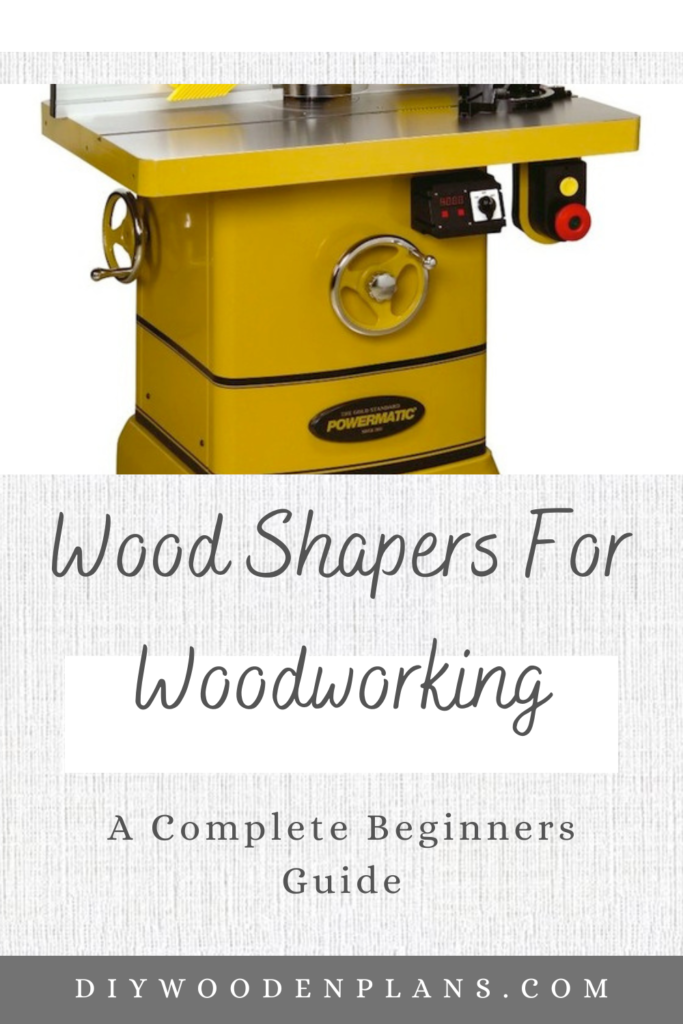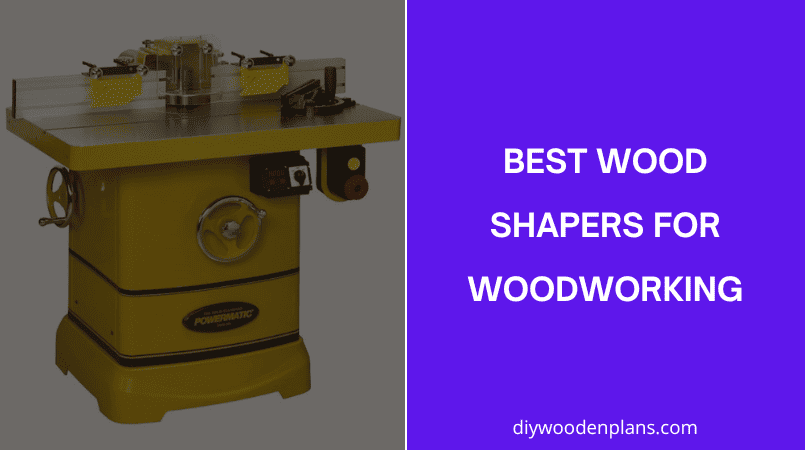YOUR NO 1 WOODWORKING POWER TOOLS RESOURCE WEBSITE
Wood Shapers For Woodworking (A Complete Beginners Guide + Tips & Tricks)

Disclosure: If you click on some of the links, we may earn a small referral fee. Please know that we only recommend products that we use and believe will add value to our readers.
Wood Shapers – Woodworking Power Tool
Shapers are one of the most versatile and powerful tool that woodworkers can have in their workshop. A shaper can be used for everything from creating custom moldings to cutting dadoes and rabbets.
Sometimes labelled as hazardous and only suitable for large commercial operations, wood shapers can be the most versatile and flexible power tool in your woodworking shop.
This is especially true for those woodworkers who a contoured decorative curve or a moulded edge makes the difference between a finished project and an unfinished project.
In this article, contrary to popular opinion, I will demonstrate that with modern tooling and proper safety techniques, the shaper is the most cost-effective, practical and safest tool for your woodworking operations.
Related: Take a look at my article on the 9 Must-Have Woodworking Power Tools For Every Workshop
What are Wood Shapers?
The shaper also referred to as a “spindle moulder” in the UK, is a simple machine commonly used to shape the edges of stock. Cutting occurs by hand-feeding the stock against a vertical rotating cutter placed on a spindle.
Some shapers may have multiple spindles with the cutter having multiple cutting edges that rotate at a speed between 7000 to 10,000 RPM.
Unlike some other stationary power tools, shapers can have their stock fed from any direction.
Fences hold the stock for straight-line shaping, while guide pins hold the stock for curved shaping
Shapers that are reversible are more convenient because, at the flick of a switch, the rotation of the cutter can be reversed, allowing the workpiece to be fed from either side of the unit.
Shapers are usually sold with electric motors between half and maximum horsepower, or, in some cases, more.
Related Article: Jointer Power Tools Woodworking | Overview | 6 Factors To Consider Before Buying One
What Can I Do With A Shaper?

The shaper is the most versatile tool in my workshop. If I am not using it to cut ornamental edges on straight stock, I am using it to chamfer of angle or stile components or mill rail or raise panels.
It is an excellent option for applying any profile imaginable to a component, pattern shaping, cutting tenons, milling components to final width, cutting circular objects, rabbets and grooves, lock miters, milling tongue and groove profiles, reproducing antique casing and sash components, and so much more.
Of course, these operations can be carried out by other machines in the shop, but a properly set-up woodworking shaper will perform many of these tasks easily, faster, efficiently, and more accurately.
How Does The Shaper Compare With a Router?

The shaper in a sense is just an upside-down router that is permanently set in a frame. The shaper’s cutters produce results that are very similar to that of the routers. Nevertheless, their differences are significant, and the shaper should be looked at as a completely different tool from the router.
Shapers are not only bigger but also more powerful than routers as they can cut much larger profiles, such as for raised-panel doors and crown moulding, and quickly drive custom-made bits fabricated with unique profiles.
Note that the shaper cutters cannot be exchanged with router bits. A collar can be placed over the cutter of a shaper to mimic the guide or pilot tip on router bits. This sets a cap on the amount of stock to be removed.
Generally, for certain kinds of projects, the stationary nature of the shaper is preferred. Whereas, in other cases, the portability of the router poses a distinct advantage.
For a complete comparison check out this article: wood shaper vs router table: which one should I buy as a woodworker?
How To Properly Setup The Shaper
Because some, if not all of the shaper’s cutters are exposed, this tool poses great danger to the fingers and hands if not properly setup.
To set up the shaper, start by making sure the knives and cutters are fastened correctly. Before starting the machine, position a piece of scrap adjacent to the cutters and check to see that the shaper cuts out the profile you want. If you are using a cutter with a guide collar on top, make sure that preferably, a quarter inch of the stock will remain at the level of the collar to act as a guide for the workpiece.
Now put on the shaper while paying extensive attention to safety and keeping whatever guards the tool has in place and using hold-downs and pushers.
Safety Precautions To Take When Shaping Stock With a Shaper

The shaper has left a negative reputation in the eyes of many as being a very dangerous machine. You may have even heard horror stories of kickbacks, flying cutters and other terrifying workshop disasters. In my opinion, these mishaps are a product of poor safety and improper usage.
When the shaper is not handled with care, it can be a very dangerous workshop tool. Those that know me very well know that I usually emphasize safety because It is not uncommon for the thrill of woodworking to carry us away.
You must respect its rapidly rotating cutter, taking care not only by keeping your hands at a safe distance from it but also by presenting the workpiece properly.
Present the workpiece so that the rotation of the blade is spinning into the wood. The shaper might jerk the piece out of your hands or pull your hands into the cutter if you do the opposite.
While it is impossible to adequately describe safe practices while using the shaper in this brief review, here is a summary.
- Read the instruction manual carefully before usage
- Only trained personnel should be allowed to operate wood shapers
- A power tool should not be used without putting on personal protective equipment. The shaper is no exclusion.
- Also do not wear loose clothing, work gloves, neckties, rings etc when using a shaper.
- Use the cutter and spindle speed that is suited for the job
- Regularly inspect the moving parts of the shaper for signs of wear and also check the spindle for excessive runout.
- Ensure that guards are in the right position.
- Before turning on the power, making sure that the spindle is square with the shaper table and that the spindle knives are properly adjusted and fastened.
- Operate only at speeds recommended by the manufacturer
- You can use a jig to fasten the work securely
- Cut with the grain rather than against it
- Don’t try to shape heavily knotted or badly warped stock.
- Shape only one piece of stock at a time.
- Don’t make extremely deep cuts. Instead of one, make two passes or more.
- Remove a portion of the waste at a time.
- Stand out of the path of the piece and not behind it.
- Instead of shaping small pieces of stock, shape a longer one and cut it to the length or shape you want after you have finished shaping its edges.
- Turn off the power when making any adjustments to the setup or when not in use.
Here is a more comprehensive list of the safety precautions to take when using woodworking power tools
How Much Does A Shaper Cost?
In today’s market, two types of shapers are being sold; the freestanding models and the benchtop models. The benchtop models are more common, less expensive and take up less space. However, freestanding models have more power and larger tables that make it easier to keep the workpiece stable and fixed.
Simple benchtop shaper models could be available in the $500-$600 range, but modern, high-end, CNC controlled with fence adjustments, motorized spindle height and 15HP motors, shapers cost as much as $60,000.
I will recommend the Powermatic PM2700 5HP wood shaper shaper because it strikes a balance between a simple and a modern woodworking shaper.
See this article for 6 best wood shaper recommendations
Final Thoughts
Not everyone needs a shaper since a variety of other tools can perform shaping tasks. However, the higher speed of the shaper produces smoother, more precise cuts while taking less setup time.
Is the shaper part of your woodworking power tool portfolio? Do you use it for your projects? I would like to hear from you. Drop your thoughts in the comment section below this article.
In the meantime, you can check out my article on using the lathe woodworking power tool (beginner guide)
Pinterest Image

Enjoy our articles? You can follow us on Pinterest for more woodworking power tools tips and tricks.
Save on selected power tools from top brands - Shop Now on Zoro.



